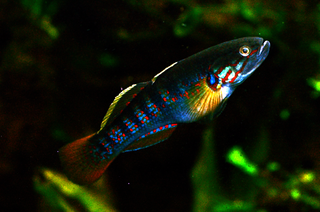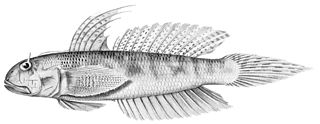
Eleotridae is a family of fish commonly known as sleeper gobies, with about 34 genera and 180 species. Most species are found in the tropical Indo-Pacific region, but there are also species in subtropical and temperate regions, warmer parts of the Americas and near the Atlantic coast in Africa. While many eleotrids pass through a planktonic stage in the sea and some spend their entire lives in the sea; as adults, the majority live in freshwater streams and brackish water. One of its genera, Caecieleotris, is troglobitic. They are especially important as predators in the freshwater stream ecosystems on oceanic islands such as New Zealand and Hawaii that otherwise lack the predatory fish families typical of nearby continents, such as catfish. Anatomically, they are similar to the gobies (Gobiidae), though unlike the majority of gobies, they do not have a pelvic sucker.

Brachygobius is a small genus of gobies. They are popular aquarium fish where a number of species are sold as bumblebee gobies because their colours are similar to those of bumblebees.

Acentrogobius is a genus of gobies native to marine, fresh and brackish waters of the coasts of the Indian Ocean and the western Pacific Ocean.
Awaous is a genus of fish in the family Gobiidae, the gobies. They are native to fresh, marine and brackish waters from Africa to the Americas.

Gobius is a genus of fish in the family Gobiidae native to fresh, brackish and marine waters of and around Europe, Africa and Asia. It contains the typical gobies, being the type genus of the formerly recognised subfamily Gobiinae and family and the namesake genus of its order Gobiiformes.
Taenioides is a genus of gobies native to fresh, brackish, and marine waters of the coastal areas of the Indian Ocean and the western Pacific Ocean.

The Gobiiformes are an order of fish that includes the gobies and their relatives. The order, which was previously considered a suborder of Perciformes, is made up of about 2,211 species that are divided between seven families. Phylogenetic relationships of the Gobiiformes have been elucidated using molecular data. Gobiiforms are primarily small species that live in marine water, but roughly 10% of these species inhabit fresh water. This order is composed chiefly of benthic or burrowing species; like many other benthic fishes, most gobiiforms do not have a gas bladder or any other means of controlling their buoyancy in water, so they must spend most of their time on or near the bottom. Gobiiformes means "goby-like".

Tomiyamichthys is a genus of gobies found from the Red Sea through the Indian Ocean to the western Pacific Ocean.

Oxyurichthys microlepis, commonly known as the maned goby, is a species of goby native to tropical marine and brackish waters along the coasts of the Indian Ocean from Africa to the western Pacific Ocean where it occurs in estuaries and inshore waters to depths of about 75 metres (246 ft). It occurs in the Mekong Delta and is suspected to use the tidal flow up the river to reach as far inland as Cambodia. This species can reach a length of 13.5 centimetres (5.3 in) TL. It is of minor importance to local commercial fisheries and can also be found in the aquarium trade.

True gobies were a subfamily, the Gobiinae, of the goby family Gobiidae, although the 5th edition of the Fishes of the World does not subdivide the Gobiidae into subfamilies. They are found in all oceans and a few rivers and lakes, but most live in warm waters. Altogether, the Gobiinae unite about 1149 described species in 160 genera, and new ones are still being discovered in numbers.

Cryptocentrus, also known as Watchman gobies, and one of the genera known as shrimp gobies or prawn gobies, is a genus of gobies native to tropical marine waters of the Indian and Pacific oceans.

Tomiyamichthys russus, the Ocellated shrimpgoby, is a species of marine ray-finned fish belonging to the family Gobiidae, the typical gobies. This species is found in the Eastern Indian Ocean and Western Pacific Ocean.

Callogobius is a genus of fish in the family Gobiidae found in brackish and marine waters of the Indian and Pacific Ocean.

Drombus is a genus of gobies native to fresh, brackish and marine waters of the Indian Ocean and the western Pacific Ocean.

The wolfsnout goby, also known as the dognsout goby or cup-sponge goby, is a species of goby native to the Indian Ocean and the western Pacific Ocean. This species lives on large fan-shaped or floppy sponges, particularly Phyllospongia foliascens and Phyllospongia papyracea, growing on reefs at depths down to 15 metres (49 ft). This species grows to a length of 3.5 centimetres (1.4 in) SL. This species is the only known member of its genus. It spans benthically and is a solitary species.

Oxuderces is a genus of fish in the family Gobiidae native to fresh and brackish waters of coasts of the Indian and Pacific Ocean.

Oxyurichthys is a genus of fish in the subfamily Gobionellinae, commonly known as arrowfin gobies. They are distributed in the tropical and subtropical Indian and Pacific Oceans; one species is also known from the western Atlantic Ocean. Most species live in shallow waters under 10 meters deep over fine substrates such as silt.

Psammogobius is a genus of fish in the family Gobiidae found in the Atlantic, Indian and Pacific Ocean.

Pseudogobius is a genus of fish in the goby family, Gobiidae. It is widely distributed in tropical and temperate regions of the Indian and western Pacific Oceans. Species occur in freshwater and estuarine habitat types, such as mangroves and seagrass beds.

Varicus is a genus of fish in the family Gobiidae, the gobies. They are native to the western Atlantic Ocean.


















